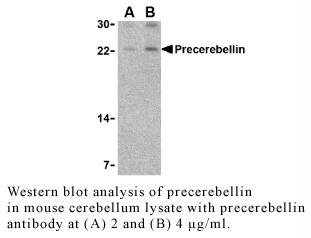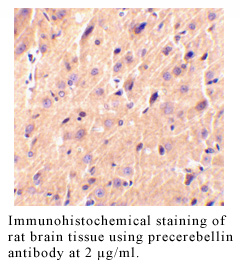Anti-Human Precerebellin (Intermediate Domain)
Data
- -
- -
Antibody DetailsProduct DetailsReactive Species Human Host Species Rabbit Immunogen PN:P204 Product Concentration 0.5 mg/ml Formulation This polyclonal antibody is formulated in phosphate buffered saline (PBS) pH 7.4 containing 0.02% sodium azide as a preservative. Storage and Handling This polyclonal antibody is stable for at least one week when stored at 2-8°C. For long term storage, aliquot in working volumes without diluting and store at –20°C in a manual defrost freezer. Avoid Repeated Freeze Thaw Cycles. Country of Origin USA Shipping Next Day Ambient RRIDAB_2831543 Each investigator should determine their own optimal working dilution for specific applications. See directions on lot specific datasheets, as information may periodically change. DescriptionDescriptionSpecificity Rabbit Anti-Human Precerebellin recognizes an epitope in the intermediate domain of Human, Mouse and Rat Precerebellin. This polyclonal antibody was purified using affinity chromatography. Background Precerebellin is the precursor of the brain-specific hexadecapeptide cerebellin, a protein with substantial similarity to the globular region of the B chain of complement component C1q.1 Cerebellin exerts neuromodulatory functions by directly stimulating norepinephrine release via the adenylate cyclase/pka- dependent signaling pathway;2 and indirectly enhances adrenocortical secretion in vivo, through a paracrine mechanism involving medullary catecholamine release.3 The active form of precerebellin is highly enriched in postsynaptic structures of cerebellar Purkinje cells in cartwheel neurons of the dorsal cochlear nucleus.4 Because precerebellin belongs to the C1q/tumor necrosis factor superfamily of secreted proteins and has similarity to adiponectin and CTRP3, it has been suggested that precerebellin posseses functions other than those already stated. PubMed References & Citations1. Urade, Y. et al. (1991) Proc. Natl. Acad. Sci. USA 88:1069 2. Mazzocchi, G. et al. (1999) J. Clin. Endocrinol. Metab. 84:632 3. Albertin, G. et al. (2000) Neuropeptides 34:7 4. Shamji, AF. et al. (1985) Proc. Natl. Acad. Sci. USA 82:7145 Technical ProtocolsCertificate of Analysis |
Related Products
- -
- -
 Products are for research use only. Not for use in diagnostic or therapeutic procedures.
Products are for research use only. Not for use in diagnostic or therapeutic procedures.




